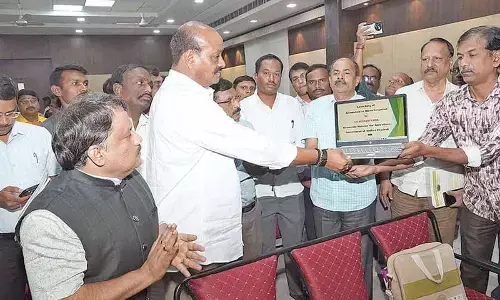Where Civilization Spells Doom

When people from plains begin tampering with mountains and forests, tragedies begin
"Do you see what I see?" the octogenarian asked me without even any introduction when I touched his feet. He was 'poojaneey' for people like me who have developed a peculiar bond with the mountains.
As the setting Sun was casting long shadows in the backdrop of the Himalayan range on that wintry evening on the banks of river Bhagirathi in Tehri Garhwal in Uttarakhand, Sunderlal Bahuguna, leaning against the trunk of the solitary tree abutting his humble dwelling facing the mighty tunnels of the dam, was asking me something else.
"These mountains...for that matter the very Nature and this mother Earth...have a peculiar way of retrieving what belongs to them. As long as man seeks shelter and shelter alone, these take care of his needs, including hunger. Once he tries to alter its ways, it first reminds him of its power gently and if he continues on the path of destruction, then it whips him out of the place. Himalayas do not accept it. They shall hit back...one day" the Mahatma of the Mountains said. That was in 2008.
Noted Gandhian Sunderlal Bahuguna, known for leading Chipko in the 1970s and the anti-Tehri dam Movement in the 1990s, breathed his last on May 21, 2021. He practised a simple and sustainable lifestyle inspiring many who immensely contributed to the cause. Bahuguna advocated for an integrated and pragmatic approach to the conservation of the entire Himalayan belt and foot-marched almost 5,000 km from Kashmir in northern India to Kohima in eastern India.
His struggles should have opened the eyes of the Indians to the destruction and its add-on consequences. No. Neither the governments nor the people woke up. It is known to everyone that the Tehri Dam has been the object of protests by environmental organizations and local people of the region in those days. Tehri Dam is the tallest dam in India and the project has spurred concerns about the environmental consequences of locating such a large dam in the fragile ecosystem of the Himalayan foothills. The Tehri dam is in the Central Himalayan Seismic Gap, a major geologic fault zone. This region was the site of a 6.8 magnitude earthquake in October 1991, with an epicenter 53 km (33 mi) from the dam. Dam proponents claim that the complex is designed to withstand an earthquake of 8.4 magnitude, but some seismologists say that earthquakes with a magnitude of 8.5 or more could occur in this region. Were such a catastrophe to occur, the potentially resulting dam-break would submerge numerous towns downstream, whose populations total near half a million.
Let us keep Tehri aside for a moment and look at the immediate concerns of Joshimath. The problem of this all important town on the path of Chardham is subsidence, it is said. The town has been sinking some 6.5 cm every year.
Land subsidence in Joshimath is primarily due to the National Thermal Power Corporation's Tapovan Vishnugad Hydro Power Project and is a very grave reminder that people are messing up with the environment to an extent that is irreversible, experts state. Rampant infrastructure development without a plan is making the fragile Himalayan ecosystem even more vulnerable to the effects of climate change which acts as a force-multiplier.
Cracks have appeared in hundreds of houses of Joshimath, the gateway to some renowned pilgrimage sites like Badrinath and Hemkund Sahib. Crucial military complexes had to be abandoned and soldiers moved out.
Do we see what Bahuguna was staring at when he was alive? It is our future and he was worried about the future of the Himalayas. Seven projects, all in Uttarakhand, have been allowed to complete construction primarily on the ground that they were over 50% complete. How many more in the entire Himalayas?
It is not just Joshimath that should cause concern to us. Reports now suggest that Karnaprayag and Landor are also witnessing a similar problem. In Chamoli area too this is happening.
There is a significant difference in the concerns expressed by the media, political parties and the authorities now and the concern of Sundarlal Bahuguna then. Today the politicians talk about rehabilitation of the people alone. How about the mountains, the forests and the rivers that can't be moved out from their places?
What is required even now is not just a 'Jan Andolan' but a 'Van Andolan'. to protect nature. Man can easily be rehabilitated by the governments concerned about 2024, but nature should be allowed to recuperate for the sake of the future. Remember the pandemic lockdown period where people in Jalandhar could see the distant snow capped mountains? We have not learnt any lessons.
Does the importance of the Hindukush-Himalayan range which stretch from Afghanistan to Myanmar for a length of about 3,000kms with a width of 222-300 kms ever get registered into our dumb heads. It is the single highest mountain range in the world. It has 110 peaks over 24,000 feet. It is 16 percent of our geographical area. While the North East Himalayas are rich in biodiversity with rain forests, its rivers are perennial sources of water and nutrients in the river basins of southern Asia. Brahmaputra, the Indus, Ganga, Meghna basins are vital to the economies of Pakistan, India, Nepal and Tibet (now under the Chinese occupation), Bhutan, Bangladesh and Myanmar. Besides being part of the Spiritual culture, the Himalayan rivers are, no doubt, a great source of hydro-electrial potential. But reckless exploitation of the same is provoking the mountains to resist such attempts.
Let us also remember that about 16 crore people live in the mountains and foothills and double the number, in the adjacent plains. Ecological devastation is sure to lead to not only sustenance challenges, but also security issues. It is not just about India, but about all those countries blessed all these years by the Himalayas. The fragility that we talk about is wrought by us.
The Himalaya is seismically and tectonically a very sensitive domain. The variety of ecosystems are sensitive. The fragility, if at all, is due to the precarious balance of these systems. We go and disturb them, the mountain becomes fragile. Every mountain is capable of rearranging its flaws and fault zones. But, when interference with its systems exceeds limits we have situations like Joshimath.
Maryanne Vollers in 'Mountains: Regal Highlands Erode Downhill' in International Wildlife (March-April 1990) says: Powerful symbols of stability and invulnerability, mountains give the impression of being eternal. They are not. The shaggy vicunas and delicate orchids that grace rugged slopes and sheltered Andean meadows are part of a fragile and mutable web of life. Mountains are constantly changing, relentlessly shaped by shifts in the Earth's surface, by gravity, rain and wind.
Once axes, plows and livestock are added to the equation, the delicate balance of life is often irrevocably altered ... In Asia, 300 million people live in the fragile upland watershed ... some of these mountain people, such as the yak herders of northern India, have managed to live in harmony with their high altitude environment. Others have not been so successful, and in recent years, the problems and pressures have grown. In the past decade, 3.5 million Afghan refugees have settled in the forests of Pakistan's Hindu Kush. Trying to eke out an existence, they have cleared vast areas of woodlands, turning many slopes into rocky wastelands.
There lies the crux of it. As long as tribes merged with nature, there was no problem. But when 'civilized' people from plains began tampering with the mountains, tragedies began.

















